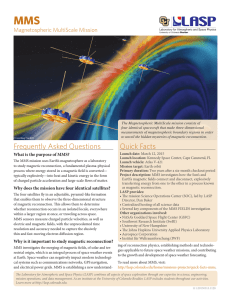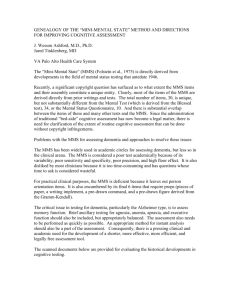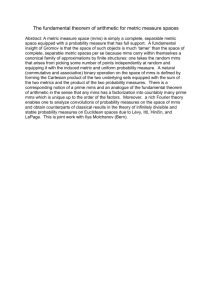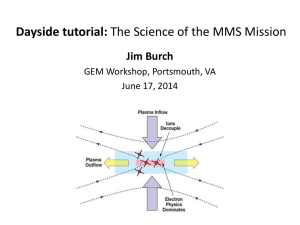Magnetospheric Multiscale Engage in NASA's newest flagship to magnetic reconnection:
advertisement
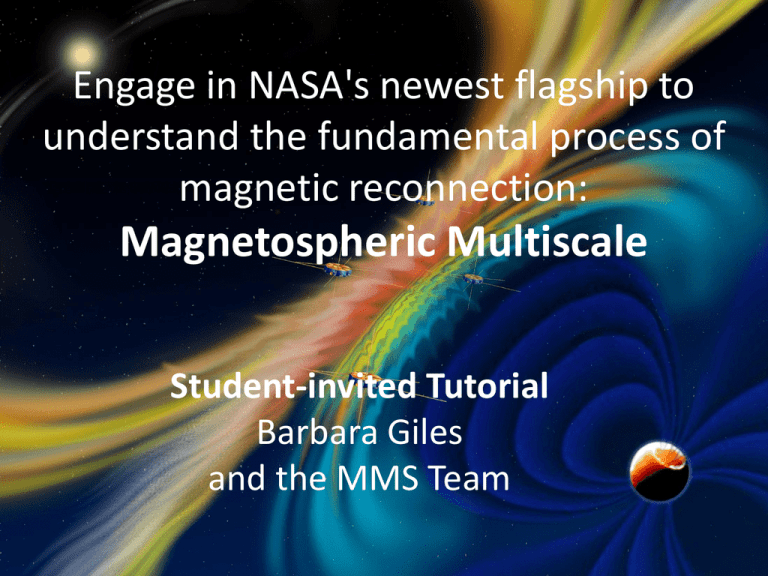
Engage in NASA's newest flagship to understand the fundamental process of magnetic reconnection: Magnetospheric Multiscale Student-invited Tutorial Barbara Giles and the MMS Team NASA Missions begin with a Formulation Authorization Document ------------------------------------------------------------------1. SPACE PHYSICS FUTURE MISSIONS WORKSHOP AT APL, APRIL 10-11, 1996 ------------------------------------------------------------------From: Jim Burch (JBurch@swri.edu) planning began in 1996, if not earlier! Dear Colleagues, George Withbroe, the Sun-Earth Connection Science Director at NASA, has appointed a core group for planning and integrating the Space Physics/Sun-Earth Connection inputs to the overall strategy of the NASA Office of Space Science. Also known as the Roadmap exercise, this activity will result in a report for review by NASA Headquarters and the advisory committees this summer and will culminate in a Woods Hole mission prioritization meeting in the summer of 1997. Members of the Sun-Earth Connection core group are listed below. This group represents most of the major subdisciplines of space physics (excluding galactic cosmic rays, which are now part of astrophysics). It is meant to be a sounding board for the community, with the goal of developing a consensus and finally a roadmap that makes a compelling case for future Sun-Earth Connection missions to the other space science disciplines, NASA administrators, Congress, and the public. Needless to say, this exercise is crucial to the future of our discipline and needs the widest possible community input. The first major activity of the Sun-Earth Connection Roadmap exercise will be a community-wide workshop to be held at the Johns Hopkins University Applied Physics Laboratory on April 10-11, 1996. Tom Potemra will be coordinating this workshop for the core group. The purpose of the workshop will be to develop science themes, identify needed advanced technologies, and propose specific missions for study. The roadmap activity will ultimately incorporate the results of studies to be supported by the New Mission Concepts NRA, which has recently been released. For the purpose of developing an agenda for the workshop, please send a brief abstract of any presentation you wish to make on science themes, advanced technology, or mission concepts to Tom Potemra (FAX: 301 953-1093, e-mail: potemra@jhu.apl.edu). While this workshop is mainly intended for the U.S. community, the program will certainly obtain international components as time goes on. Thus, the international community is welcome to attend and make inputs. Unfortunately, no travel support is available for either the international community or the U. S. community. Sun-Earth Connection Strategic Planning Integration Team Jim Burch (Chairman) Rich Vondrak (Vice-Chairman) Loren Acton Spiro Antiochos Dan Baker Jeff Forbes Rod Heelis Tim Killeen Lou Lanzerotti Marty Lee Glenn Mason Dave McComas Bob Meier Dick Mewaldt jburch@swri.edu vondrak@lepvax.gsfc.nasa.gov acton@physics.montana.edu antiochos@nrl.navy.mil baker@orion.colorado.edu forbes@zeke.colorado.edu heelis@utdallas.edu tkilleen@umich.edu ljl@physics.att.com marty.lee@unh.edu mason@sampx3.umd.edu dmccomas@lanl.gov meier@uap.nrl.navy.mil dick@citsrl.srl.caltech.edu … and we don’t get to that point without a Strategic Plan P.L. 103-62 P.L. 111-352 A personal journey … Dynamics Explorer Aug 1981- Feb 1991 Polar Feb 1996 – Apr 2008 THEMIS Feb 2007 – present IMAGE March 2000 – Dec 2005 Van Allen Probes Aug 2012 – present Geotail July1992 – current MMS Mar 2015 – present A personal journey … You are here? at your first mission? Dynamics Explorer Aug 1981- Feb 1991 Dynamics Explorer Feb 1996 – Apr 2008 THEMIS Feb 2007 – present IMAGE March 2000 – Dec 2005 Van Allen Probes Aug 2012 – present Geotail July1992 – current MMS Mar 2015 – present A personal journey … What missions are in IMAGE your future? Dynamics Explorer Geotail Dynamics Explorer March 2000 – Dec 2005 Will youFeb be1996 one of2008 the scientists that planJuly1992 long – current – Apr Aug 1981- Feb 1991 term? … that invest in the 25 year strategic planning activities? … that do the hard work to bring these missions to the community? It’s not too early to start. THEMIS Feb 2007 – present Van Allen Probes Aug 2012 – present MMS Mar 2015 – present Who’s Who on MMS? Science Working Group (SWG) Members PI and SWG Chair - Jim Burch Project Scientist and SWG Vice-Chair - Thomas Moore Deputy PI and Fields team Lead - Roy Torbert HPCA team Lead - Stephen Fuselier ASPOC team Lead - Rumi Nakamura FPI team Lead - Craig Pollock EPD team Lead - Barry Mauk Theory and Modeling Lead - Michael Hesse Science Operation Center Lead - Daniel Baker Science Operations Lead - Barbara Giles Burst Mode Lead - Robert Ergun IDS Lead - Martin Goldman IDS Lead - Mel Goldstein IDS Lead - Tai Phan Program/Project Stakeholders: HQ Program Leads – Steven Clarke, Bill Paterson, Bill Stabnow Project Leads - Craig Tooley, Brent Robertson, Ron Black/Bill Lewis MMS Science Commitment Understand the microphysics of magnetic reconnection by determining the kinetic processes occurring in the electron diffusion region that are responsible for collisionless magnetic reconnection, especially how reconnection is initiated. •Determine the role played by electron inertia and turbulence in regulating magnetic reconnection. •Determine the rate of magnetic reconnection and the parameters that control it. •Determine the role played by ion inertia and turbulence in magnetic reconnection. A Fundamental Universal Process Orbital Phases MMS employs two mission phases with inclination of 28 deg. to optimize encounters with both dayside and nightside reconnection regions. MMS Science Commitment Orbital Strategy – Day Side • Launch Mar. 12, 2015 • 28-deg. inclination, apogee 12 RE on day side • 4 mo. commissioning • Phase 1a: day side with separations 10 – 160 km • Phase 1b: day side with optimum separation • Plots show orbits in green, magnetopause crossings in red (Phases 1a and 1b), and neutral sheet crossings in orange (Phase 2). Orbital Strategy – Night Side • Launch Mar. 11, 2015 • 28-deg. inclination, apogee 12 RE on day side • Phase 2: Apogee 25 RE in tail with separations 10 – 400 km • Plots show orbits in green, magnetopause crossings in red (Phases 1a and 1b), and neutral sheet crossings in orange (Phase 2). Instrument Suite Elements and Responsibilities FIELDS - Electric and magnetic (E,B) measurements at <1 ms timing resolution (DC). Roy Torbert - UNH Fast Plasma - Image full sky at 32 energies: electrons in 30 ms, ions in 150 ms. (n, P, fe, fi). Craig Pollock - GSFC Energetic Particles - All-sky viewing of ion and electron energetic particles (20 – 500 keV) w/composition (fe, fi). Barry Mauk - APL HPCA – Composition-resolved 3D ion energy distributions (fi) of H+, He++, He+, and O+. Stephen Fuselier - SwRI ASPOC – Maintains s/c potential to ≤ 4 V. Enables valid (fi, E, B) data. Rumi Nakamura – IWF (Austria) SOC – Responsible for operating each IS, data management and archival of science data. Dan Baker - LASP Theory and Modeling – Develop models of reconnection for mission design and data interpretation. Michael Hesse - GSFC MMS Instrument Suite Fast Plasma Investigation Suite 4 Suite 3 Suite 2 Suite 1 16 Dual Electron Spectrometers 16 Dual Ion Spectrometers 4 IDPUs MMS Commissioning Timeline Multiple analyzers with different effective “detector efficiencies” are combined into de-spun azimuthal bins effects of differing crosstalk, geometric factor, MCP efficiency and gain. John Dorelli (NASA/673) put together this illustration of some 0th-order impacts the FPI team is working to correct: 1) density overestimation due to photoelectrons, 2) spin period signal in bulk velocity due to relative detector efficiencies. On-orbit Photoelectrons Dan Gershman (NASA/673) examined the FPI Burst Data and determined we will be able to map the photoelectron signal with high (<1o) angular precision and make good estimates of the signal-tonoise ratios for measured burst maps Measured data Sun Photoelectron model Data Expectations 4/15/11 Jim Burch 21 MMS and the System Observatory Web Site: https://lasp.colorado.edu/mms/sdc/ Heliophysics Mission Timeline 1995-2025 Heliophysics Mission Timeline Magnetospheric Multiscale Mission
